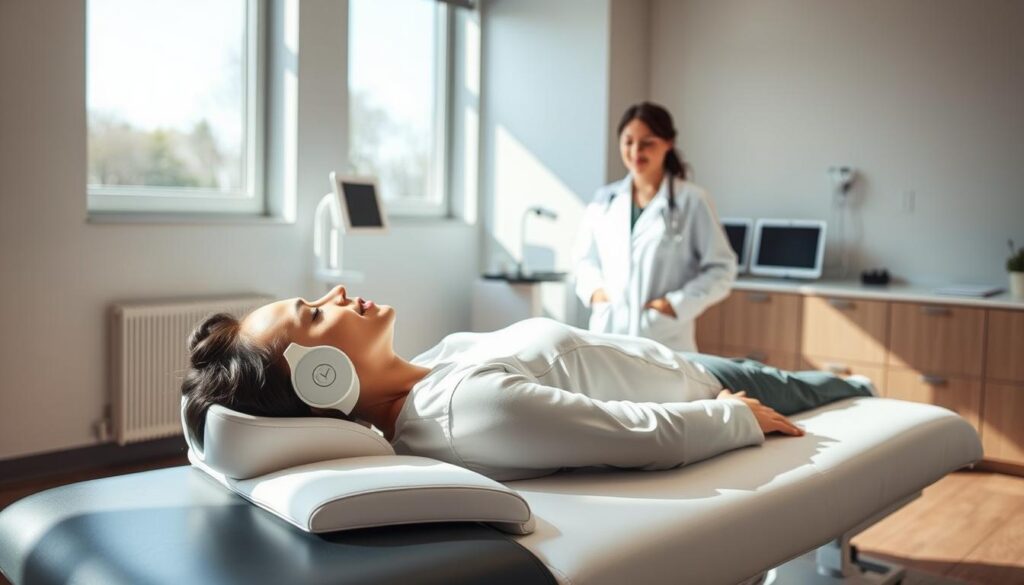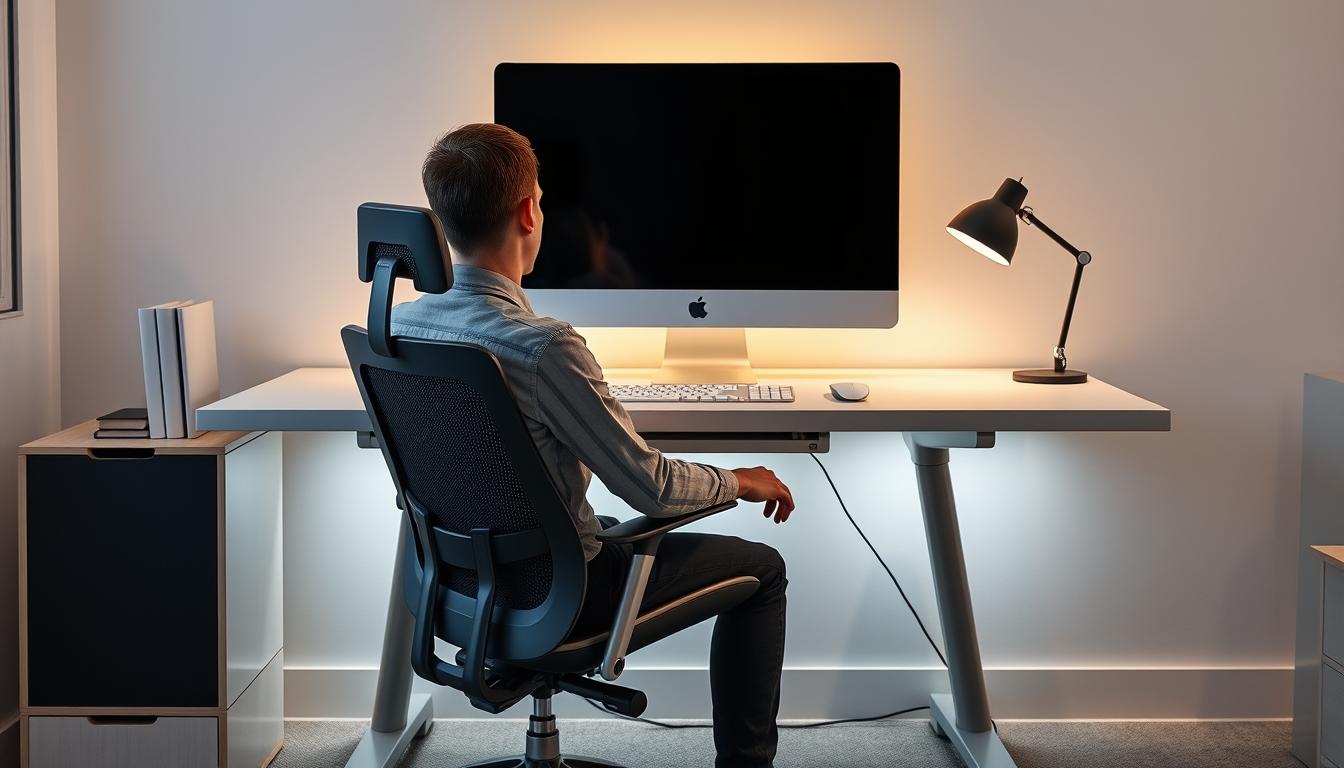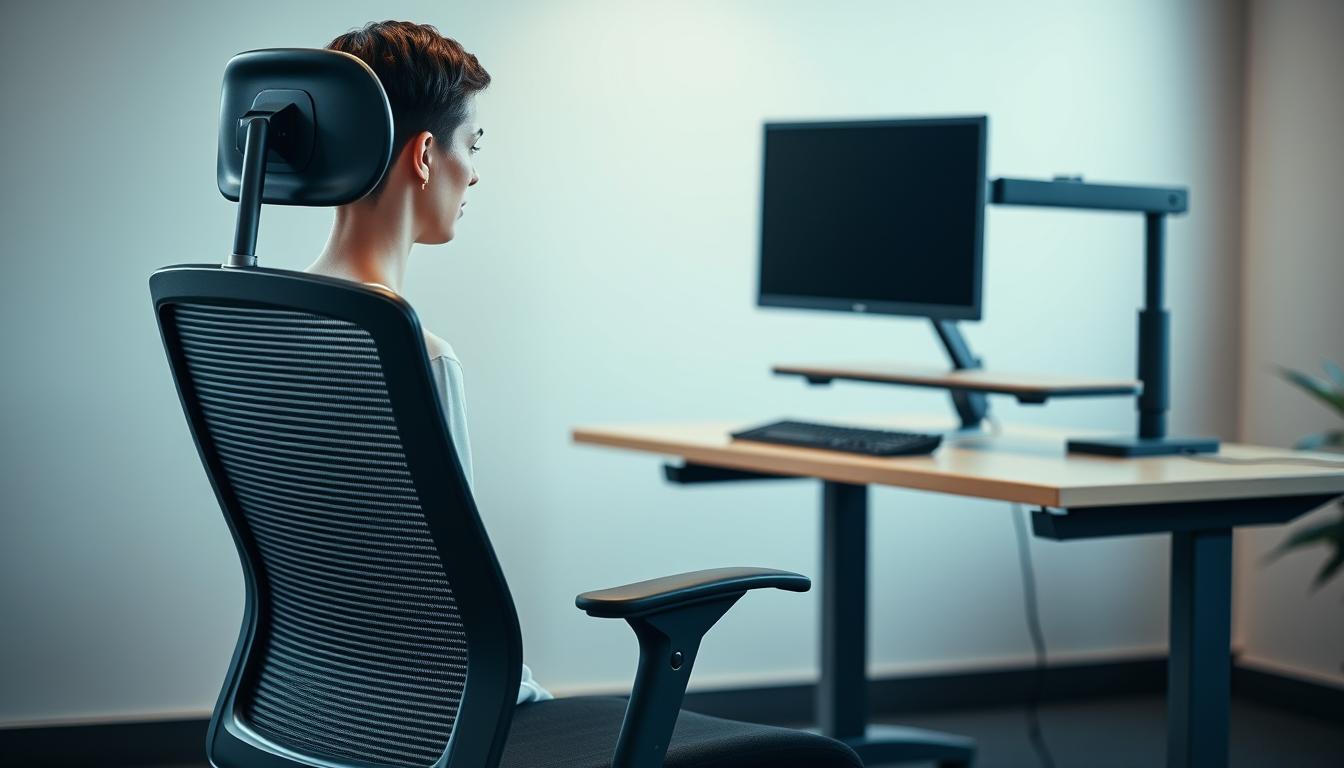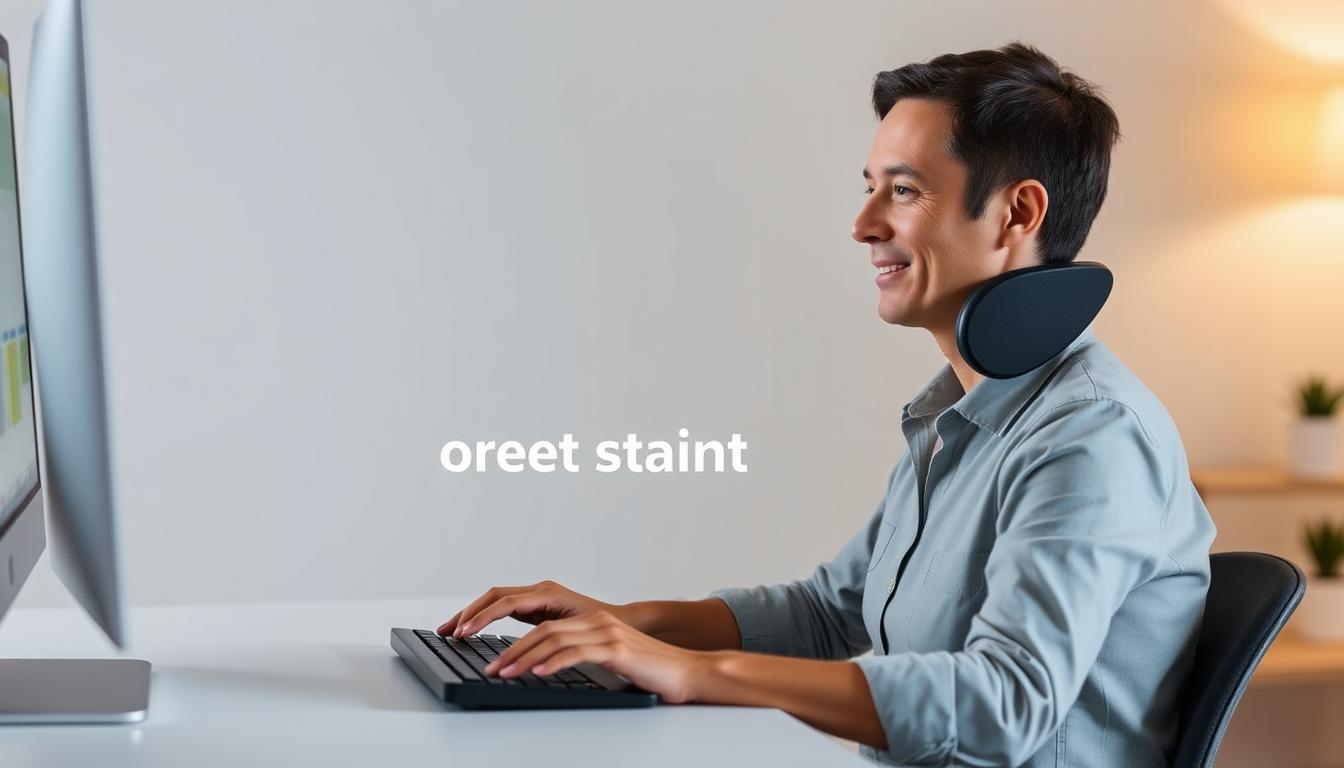In our world today, the issue called tech neck is becoming more common. It mainly comes from poor posture when using digital devices for too long. People are feeling more neck pain because they’re always on their phones, tablets, and computers.
Studies show this problem is adding to global disability. It gets worse from lots of texting and too much screen time. Knowing about tech neck and how often it happens is very important. It shows us why good ergonomics are important to stop this problem from spreading.
Understanding Tech Neck: A Modern Epidemic
Tech neck is a major problem today, linking closely to our love for digital devices. More than 70% of students and people working from home say they have neck pain. This pain can lower how well they work.
Using smartphones, tablets, and laptops a lot can make us sit badly. This bad posture can hurt right away and cause bigger health problems later. When we look down at screens, we put extra pressure on our neck and spine.
It’s really important to know how to fix our posture. If we don’t, tech neck could get much worse. Knowing about this problem can help us take better care of our health and live better.
What Is Tech Neck and Why Does It Matter?
Tech neck is the pain and discomfort from bad posture while using devices. It includes neck stiffness, headaches, and shoulder pain. These issues often come from too much time spent bent over phones, tablets, or computers.
It’s key to understand tech neck as it’s becoming more common among all ages, especially kids and adults who use tech a lot. Society’s growing screen time makes it important to address tech neck. If we ignore it, people might deal with chronic pain and a lower quality of life.
Knowing early signs of tech neck and its possible problems is essential. Taking steps to care for our necks helps avoid the negative impacts of this modern issue.
The Role of Devices in Tech Neck Development
Our lives have changed with the rise of digital devices, making it easy to stay connected. But this ease comes with a downside. Too much time on smartphones and laptops can cause bad neck posture, leading to tech neck. When we look down at our screens for too long, it strains our neck and shoulder muscles.
Research shows a clear link between device use and neck pain. As technology becomes a bigger part of our lives, its impact on our bodies becomes more clear. If we don’t keep the right posture and stay aware, our bodies suffer from stress and discomfort.
We enjoy the convenience of our devices but often forget about good posture. By changing our habits and being more aware of how we use our devices, we can avoid tech neck. It’s important to take action now as we depend more on digital devices.
The Anatomy and Mechanics of Tech Neck
Tech neck involves a problem called forward head posture (FHP). In FHP, the head sticks out in front of the spine. This messes up how the neck bones work together. It also throws off balance and makes muscles work harder, causing pain and strain.
Several key muscles suffer from FHP, including:
- Sternocleidomastoid: This muscle helps us move our heads. With tech neck, it’s forced to work too much because the head is out of place.
- Upper trapezius: This muscle lifts the shoulders and helps extend the neck. It gets strained when the head leans forward.
As we use technology more, understanding FHP is vital. Knowing how it hurts our bodies shows us how to avoid it. Learning about tech neck helps us prevent damage and keep our spines healthy.
How Poor Posture Causes Tech Neck
Poor posture is key to understanding tech neck. How people hold their heads and bodies while using devices is crucial. Forward head posture is common among those who use smartphones and computers for long hours. This posture changes the spine’s alignment and strains the neck muscles.
Forward Head Posture and Its Impact
Forward head posture happens when the head sticks out past the body’s center. This bad position causes more tension and tiredness in neck and upper back muscles. Studies show it’s widespread among frequent users of technology. The body gets used to this posture over time, leading to misalignment and worsening tech neck symptoms.
Key Symptoms Associated with Tech Neck
Symptoms of tech neck can include:
- Muscular spasms in the neck and shoulders
- Joint stiffness affecting mobility
- Frequent headaches, particularly tension headaches
- Lower back discomfort
Noticing these symptoms early helps in getting the right help. This assists people in keeping a better posture and avoiding tech neck issues.
Risk Factors for Developing Tech Neck
Tech neck is becoming more common due to several factors. Knowing these can help us see if we’re at risk. The main causes are things related to age and the way we live. Both are key in getting tech neck and how it changes our daily lives.
Age and Lifestyle Influences
Age plays a big role in tech neck chances. Young people, especially those glued to their phones and laptops, are more likely to get it. It’s a myth that only older adults suffer from tech neck. Younger people’s high device use actually flips the script.
How we live can make tech neck worse. Spending a lot of time sitting and using tech can harm our posture. This adds extra pressure on our neck muscles. Also, a bad setup at work, like desks that are too high or chairs that don’t support us, can make things worse. Understanding age and lifestyle helps in tackling tech neck the right way.
Preventive Measures to Avoid Tech Neck
To fight tech neck, we need to make changes that help us sit and work better. Creating a workspace that helps you keep a good posture can really help. It also lowers the chance of neck and shoulder pain.
Ergonomic Adjustments in Your Workspace
Simple changes in your workspace can stop tech neck. Here’s what you can do:
- Set your chair so your feet stay flat on the ground. This helps your posture.
- Keep your monitor at eye level to avoid leaning your head forward.
- Use an ergonomic keyboard and mouse to keep your wrists from getting sore.
- Try a standing desk so you can stand sometimes while you work.
- Take breaks to stand or stretch every 30 to 60 minutes. This resets your posture.
Ergonomic tools and apps also help a lot. They remind you to take breaks or stretch. This makes your workspace better for your health and stops tech neck.
Simple Exercises to Relieve Tech Neck Symptoms
Do you have tech neck symptoms? You can feel better with easy exercises, no matter if you’re at home or work. Adding these moves to your day helps soothe your neck and boosts its health.
Try these gentle stretches:
- Neck Tilts: Sit or stand straight. Lean your head toward one shoulder, holding it there for 15-30 seconds. Do the same on the opposite side.
- Chin Tucks: While sitting, draw your chin toward your neck. Keep your head level. Hold briefly, then let go. It’s good for your upper spine.
- Shoulder Blade Squeezes: Sit or stand up tall. Bring your shoulder blades together. Hold for five seconds, then relax. Do it a few times to ease stress.
Adding these tech neck exercises to your routine can really make a difference. They ease pain caused by too much screen use. Stick with them to see great results in how your neck feels and moves.
Treatment Options for Tech Neck Relief
People with tech neck need effective treatments for relief. Using several methods together works best. This way, different sides of the problem are tackled.
Physical therapy is a key treatment for tech neck. Licensed therapists make exercise plans to strengthen the neck and shoulders. These exercises improve posture and reduce pain. Therapists also show how to set up work and home spaces to reduce strain.
Correcting your posture is vital for managing pain. Learning the right way to sit while using tech is important. Taking breaks from screens helps muscles relax and recover. Adding simple stretches to your day helps ease tightness and tension.
Ergonomic tools, like adjustable desks and comfy chairs, make a big difference in posture and comfort. Using things like monitor stands to keep screens at eye level helps maintain a natural position for the head and neck.
It’s important to see healthcare pros for tailored treatment plans. Everyone has different symptoms and discomfort levels. Getting personalized help ensures effective pain management and long-term relief that suits you.

Conclusion
Tech neck happens because we use devices too much, and it’s a big health problem. Living in a world filled with technology, it’s key to know about this. If we ignore it, it can cause serious health issues later on.
We’ve talked about what causes tech neck and how devices make it worse. It’s really important to spot the signs early. By fixing how we sit and doing exercises, we can keep our necks healthy.
Knowing about tech neck helps us rethink our daily habits and how we sit or stand. To live better in today’s digital world, we must start making changes right away. It’s time to take care of our neck health and improve how we hold ourselves.



